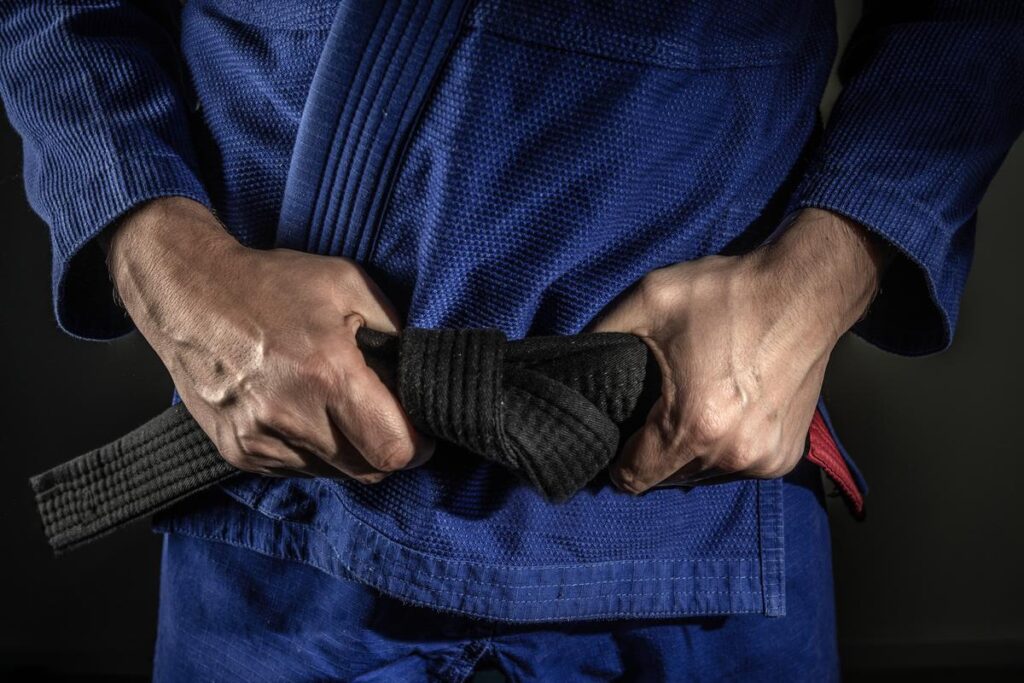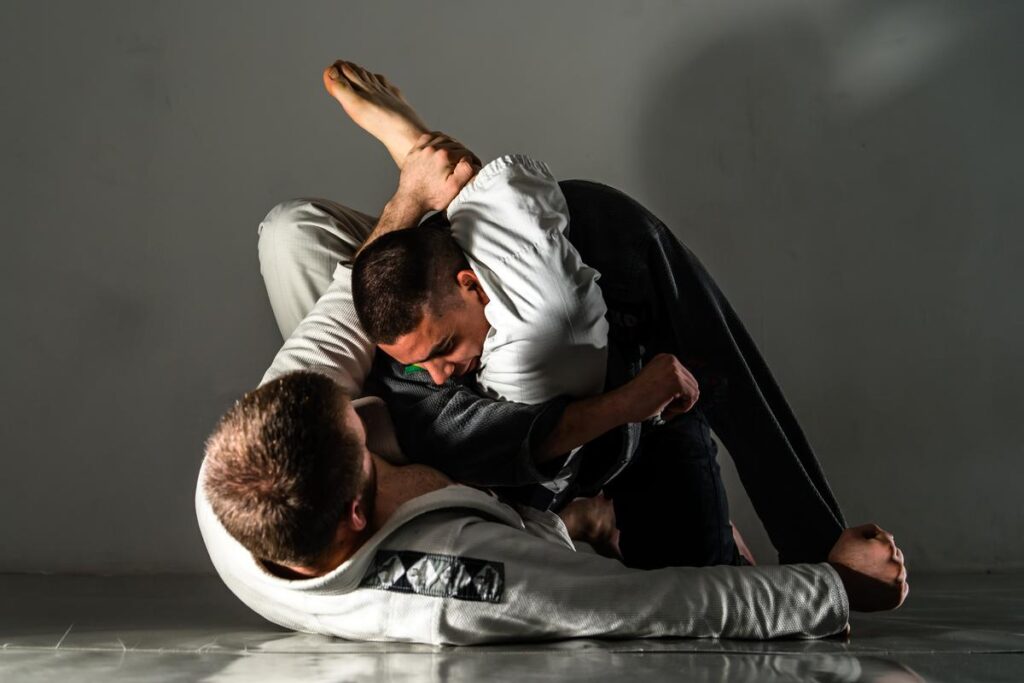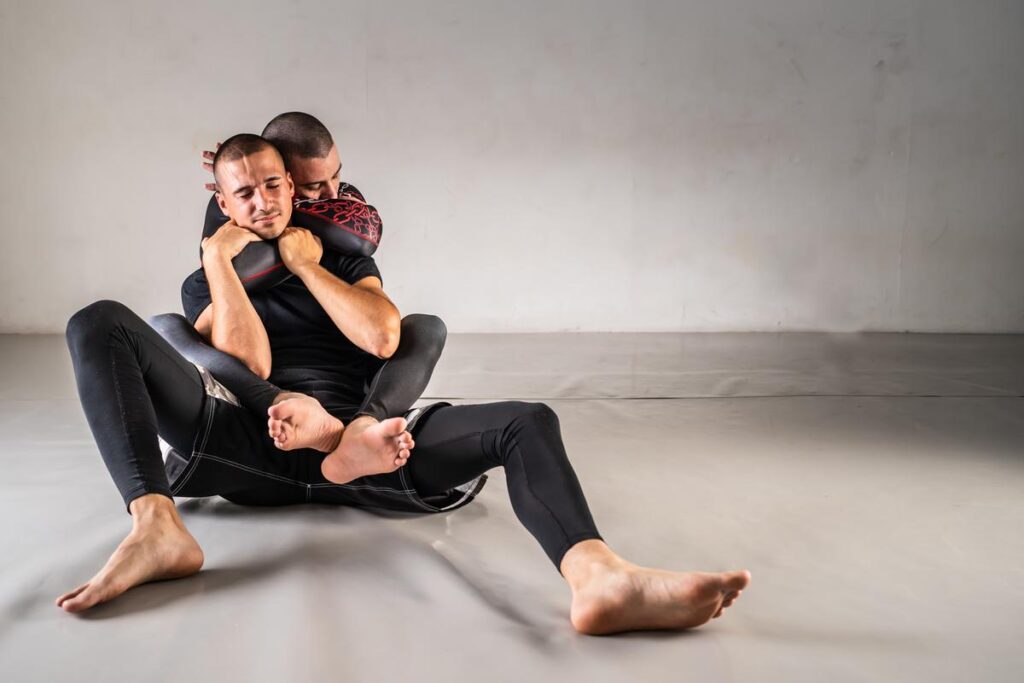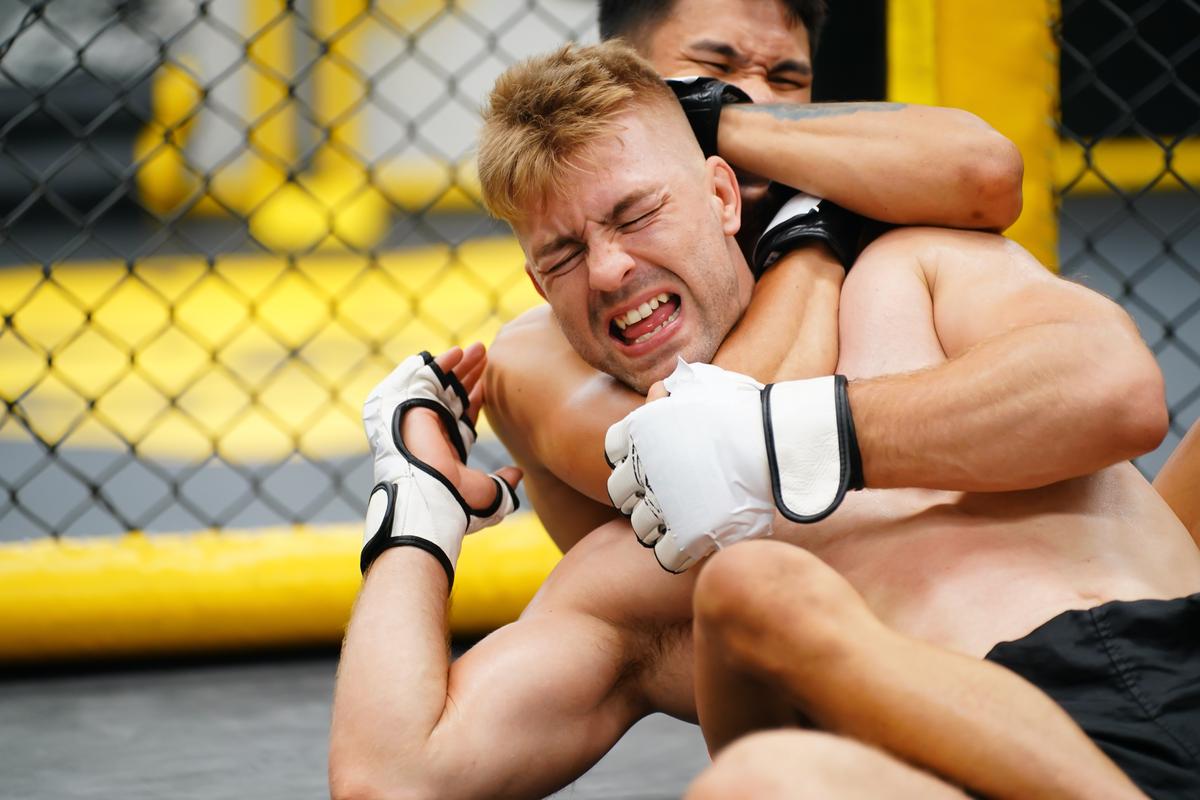In Brazilian jiu-jitsu (BJJ), the body lock position refers to controlling your opponent’s torso by clasping your hands together around their back. White belts can also ask this question “Are Body Lock Takedowns Competition Legal in Jiu Jitsu”
From this position, you can execute several different takedowns to bring your opponent to the mat and gain top position.
But are body lock takedowns competition legal in jiu-jitsu? Let’s take a look at some common body lock takedown techniques and analyze their legality according to jiu-jitsu competition rules.
Some examples of effective takedowns that can be performed from the body lock position are:
- Outside Trip – Hook your leg around uke’s leg to unbalance them and take them down
- Head and Arm Throw – Bend down to grab head and arm, then throw uke over your shoulder/hip
- Belly-to-Back Suplex – Lift and flip uke over your head landing on their back
- Bear Hug Slam – Grab around uke’s waist/chest, lift and drive them down
- Knee Tap/Single Leg – Lift uke’s leg while blocking other leg with your knee
These takedowns allow you to score on your opponent from a dominant position and earn takedown points in a match. But are these body lock takedown techniques legal to use in jiu-jitsu competition?
According to International Brazilian Jiu-Jitsu Federation (IBJJF) rules, body lock takedowns are permitted techniques to score points and takedowns in matches and tournaments.
The rulebook specifically lists “takedowns by grabbing the opponent with both arms around the opponent’s torso” under legal takedown methods.
However, competitors must execute these takedowns properly without intentionally slamming or spiking their opponent.
Control is important for both safety and to maintain dominant position after completing the takedown. Used strategically, body lock takedowns can be very effective for setting the tone of a match.
When we talk about wrist lock in bjj then one question also appears that “Can White Belts Do Wrist Lock BJJ” and “Are Wrist Locks Legal in BJJ?“
Now, we are going further on this “Are Body Lock Takedowns Competition Legal in Jiu Jitsu“
Legality of Body Lock Takedowns on Are Body Lock Takedowns Competition Legal in Jiu Jitsu

The International Brazilian Jiu-Jitsu Federation (IBJJF) is the governing body that oversees major jiu-jitsu tournaments worldwide.
They have established standardized rules that define permitted techniques and scoring across belt levels and age groups. This includes regulations around which takedowns are legal versus illegal.
So what do IBJJF rules have to say about the legality of body lock takedowns in jiu-jitsu competition?
According to the official IBJJF rules, body lock takedowns are explicitly listed as legal techniques to score takedown points in jiu-jitsu matches. The rules state under Article 5 regarding permitted takedowns:
“Takedowns by grabbing the opponent with both arms around the opponent’s torso, with or without grip on the sleeves, are permitted.”
This directly covers takedowns executed from a body lock position, where you control your opponent’s torso by clasping your hands together around their upper body. Examples of permitted body lock takedowns include:
- Bear hug slam
- Head and arm throw
- Belly-to-back suplex
- Outside trip
- Knee tap/single leg takedown
As long as competitors perform these takedowns by securing a body lock position around the opponent’s torso, without gripping the legs, they are legal techniques according to IBJJF rules.
The critical factor is avoiding excessive slamming or spiking of your opponent into the ground when finishing takedowns.
There have been instances of serious injuries from uncontrolled body lock takedown slams. Competitor safety is paramount.
This means competitors must have good control over their opponent during the entire takedown motion.
Simply lifting and driving your opponent down forcefully from a body lock is permitted within reason. But intentionally elevating and spiking them down with excessive force is illegal.
Smooth, controlled execution allows body lock takedowns to be applied safely and effectively.
It shows greater skill to perform them technically rather than relying on brute strength and slamming. Referees will penalize competitors for any uncontrolled, dangerous takedown behavior.
Skilled use of body lock takedowns is explicitly legal according to IBJJF jiu-jitsu competition rules. But competitors must execute them with control and safety in mind.
When performed properly, body lock takedowns allow you to successfully bring your opponent to the mat from a standing position and gain an advantageous scoring position.
Effective Competition Takedowns from Body Lock
Once you have secured a body lock position during a jiu-jitsu match by controlling your opponent’s torso with your hands clasped together, there are several effective takedown techniques you can execute to bring the fight to the ground.

The major body lock takedown options that can help you score in competition are:
Outside Trip
The outside trip is one of the most widely used takedowns from the body lock. After securing your grip, you hook your leg around the outside of your opponent’s leg closest to you.
Drive your hips into them while off-balancing their base using your leg hook. This causes them to trip over and fall.
The outside trip is an energy efficient takedown that utilizes both leverage and timing. It allows you to take down larger, stronger opponents when executed precisely.
However, it does require getting into an exposed position temporarily, so set it up well. Mastering the outside trip from a body lock gives you a high percentage takedown.
Head and Arm Throw
By controlling your opponent’s head and locking up one arm from a body lock, you can throw them over your shoulder or hip. Bend down to grip behind the head while trapping an arm.
Lift up with your legs and hips as you twist over your pivot foot. Time their forward momentum to swing them over.
The head and arm throw is powerful but requires good grip strength and wrestling proficiency to leverage your opponent’s momentum.
Drill it extensively for reliability in competition. This technique shines in the gi where you can control the collar.
Belly-to-Back Suplex
Though not always the highest percentage takedown, the belly-to-back suplex can be used as a highlight reel throw if you get the body lock dialed in.
Hoist your opponent up onto your hips, then bridge back and upside down to drive them into the mat behind you.
Make sure you have the grip, back arch and bridge strength to lift your opponent fully before attempting the suplex. Going 3/4ths of the way up risks injury.
While lower percentage, this body lock takedown makes a statement if executed flawlessly.
Bear Hug Slam
By controlling your opponent around their waist in a bear hug and lifting up, you can power them straight down into the mat for a high-impact takedown.
For better control, grip higher under the armpits rather than the waist.
Slamming from a bear hug is legal but don’t spike excessively. Use just enough force to put them down. This technique works well against bigger opponents when you time their forward pressure. But it requires substantial raw power.
Single Leg Takedown
By controlling one leg up in the air from a body lock, similar to a double leg, you can take your opponent down. Block their other leg from posting out using your knee. Hop back and use your body lock grip to elevate and finish.
This functions akin to a single leg takedown but with a body lock for the upper body rather than head control. It takes less strength than a double leg while still bringing your opponent to the mat efficiently.
These five techniques represent your primary takedown options from a body lock position in jiu-jitsu matches. Which one you choose will depend on factors like your weight class, opponent’s style, gi versus no-gi etc.
Train them all for maximum versatility. Mastering just one body lock takedown can be a game-changer in competition.
Strategic Use of Body Lock Takedowns

While body lock takedowns are permitted and effective techniques, they should not be overused blindly in competition. Smart strategic use requires knowing when to apply body locks versus alternative takedowns based on several factors.
When to Use Body Lock Takedowns
Some scenarios where going for the body lock could be your best takedown option:
- Opponent is taller/longer – Body lock negates their reach advantage
- You have superior grip strength to control/break their posture
- Countering a single leg shot – Spin to the back for a body lock
- Gi match where controlling the back is easier
- Repeatedly hit the same body lock setup in training
- Opponent is staying light and moving a lot – Body lock controls their movement
- Significant size/strength advantage over your opponent
- In No Gi, opponent playing a bent over stance presenting their back
- As a bailout option when other takedowns aren’t working
When Other Takedowns May Work Better
Instances where alternative takedowns like shots may be preferable:
- No Gi match where body lock is harder to establish and maintain
- Opponent has very strong defensive grip fighting ability
- Giving up significant size – Lifts and slams will be challenging
- Prefer taking the back rather than a body lock for control
- Training partner you know defends body lock takedowns well
- Want to conserve grip strength for ground game
- Opponent presents their legs/hips more than their upper body
- Drilled explosive shot setups more frequently than body lock timing
The element of surprise also plays a role. Repeatedly hitting the same body lock setup makes you predictable. Mixing up your takedown game keeps opponents guessing.
Safely Setting Up the Body Lock
The safest way to enter into a body lock position for takedowns is by combining it with other techniques rather than reaching blindly. For example:
- Use wrist control to spin opponent into body lock
- Fake a shot, come back up into a body lock when they sprawl
- From the clinch, release a hand to spin behind into back control
- Control a wrist and elbow to maneuver into a back hug
- Spin off an opponent’s underhook to take their back
Drill takedown chains and combinations relentlessly until body lock entries become smooth and instinctual. This allows you to transition safely against resistance.
Gi vs No-Gi Gripping Considerations
Gi matches make establishing and maintaining the body lock grip easier with the ability to control the back of the gi. In No Gi, you have to rely more on connected wrist control and squeezing with your arms. No Gi body lock attacks are often triggered instantly off a scramble or spin behind rather than forcing the position.
Modify your grips, but body locks can still work well No Gi once you adapt your set ups for the situation. Just don’t get over-committed leaving your own back exposed.
Choose techniques strategically in the context of each match based on these factors for the highest chance of takedown success.
Safety and Control in Executing Body Lock Takedowns on Are Body Lock Takedowns Competition Legal in Jiu Jitsu
While body lock takedowns are legal and effective techniques in jiu-jitsu competition, competitors must execute them with safety and control as the top priorities. Any takedown done recklessly risks injury to your opponent and potential disqualification. Here are some guidelines on safely applying body lock takedowns:
Control the Takedown Motion
The key is avoiding excessive acceleration or force when finishing takedowns from the body lock position. Lift your opponent just enough off the ground and ease them down to the mat. Do not intentionally spike or slam them.
Keep your head up and back straight rather than bending down during the takedown. Maintain even pressure with your arms – pulling too much with one side can twist the body.
Go slowly at first during training until the takedown motion feels smooth and controlled. Gradually increase speed with practice. But focus on technical precision over raw power.
Are Body Lock Takedowns Competition Legal in Jiu Jitsu
Pay close attention to how your training partner lands on the mat. Make sure they don’t crash straight down onto their head.
Assist their fall into a side breakfall if needed – don’t just release the body lock and let them drop. This prevents them landing awkwardly.
Going too fast or finishing the takedown unevenly risks serious injuries for your partner. Keep their safety first.
Maintain Dominant Position
It is not enough to just take your opponent down – you must control them through the landing and settle into a dominant position.
Hold your body lock grip tight as you hit the mat to establish top position. Grapevine their legs using your own if needed to prevent escape.
Avoid landing flat on your stomach or exposing your own back. Stay heavy on top using chest pressure.
If executed correctly, you should end up in full mount, side control or north-south after a body lock takedown. This allows you to go immediately for submissions or points.
Drill Maintaining Control
Repeatedly drill body lock takedown entries and finishes with compliant partners emphasizing control. Go to the edge of the mats to practice takedowns safely.
Increase resistance gradually over time adding speed, misdirection etc. But have your partner provide feedback if at any point control is lost.
Practicing takedowns in isolation is also beneficial before integrating them into live sparring. Use thick padded mats if available.
Technical Mastery Over Strength
While physical strength can be an asset, overly relying on power and speed can compromise safety and technique.
Strive to develop finesse in leveraging body position and grips so that control comes from skill rather than strength. This takes longer to cultivate but pays off.
If brute strength allows you to power through a takedown, consider whether speed and force needs to be dialed back.
Make safety and precision your goals rather than simply dominating your training partner. Leave your ego at the door.
Wrapping Up On “Are Body Lock Takedowns Competition Legal in Jiu Jitsu”
In summary, body lock takedowns represent effective, legal techniques to score points in jiu-jitsu matches. Key takeaways to using them successfully:
- Master proper set ups to establish the body lock position safely
- Apply leverage and angles – do not simply muscle your opponent
- Drill extensively with a cooperative partner emphasizing control
- Lift and lower your opponent gently – avoid excessive slamming
- Assist their landing to avoid dangerous falls
- Maintain top position after the takedown is complete
- Sharpen technical skill rather than relying on athleticism alone
- Make safety the number one priority over landing takedowns
With repeated practice under guidance, body lock takedowns can be a valuable addition to your competition takedown game within the boundaries of law and safety.
Do not neglect developing well-rounded skills for both Gi and No-Gi competition. A blend of takedowns, throws and trips keeps opponents guessing.
Train hard, compete intelligently and respect your partners by executing all techniques, including body lock takedowns, with the utmost control. This encourages an environment of growth while minimizing injury risks in the art and sport of jiu-jitsu.
FAQs On “Are Body Lock Takedowns Competition Legal in Jiu Jitsu”
Are body lock takedowns allowed in IBJJF tournaments?
Yes, body lock takedowns are permitted by IBJJF rules as long as they are executed safely and with control.
What are some examples of body lock takedown techniques?
Common body lock takedowns include outside trip, bear hug, head and arm throw, suplex, and single/double leg takedowns while controlling the upper body.
Can you slam or spike your opponent from a body lock in competition?
No, excessive slamming or spiking is illegal. You must lower your opponent safely under control.
Does securing a body lock position first make a takedown legal?
No, you still have to actually complete the takedown without dangerous throwing or dropping.
Is using brute strength rather than technique permitted for body locks?
While strength can help, technique should take precedence for safety. Don’t muscle or rush takedowns.
Can you score points for a body lock takedown in BJJ matches?
Yes, properly executed body lock takedowns score just like any other legal takedown.
Do body lock takedown rules differ between Gi and No-Gi divisions?
No, the rules are the same. Gripping techniques will differ between the two though.
What if my opponent lands wrongly from a body lock?
You may be penalized or disqualified if the referee deems you executed recklessly or dangerously.
